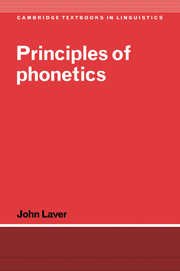Book contents
- Frontmatter
- Contents
- List of figures
- List of tables
- Preface
- Acknowledgements
- Introduction
- PART I General concepts
- PART II The analytic framework
- PART III Initiation and phonation
- PART IV Linear segmental analysis
- PART V Articulatory co-ordination and phonetic settings
- PART VI Temporal, prosodic and metrical analysis
- 14 The temporal organization of speech: segmental duration
- 15 The prosodic organization of speech: pitch and loudness
- 16 The metrical organization of speech: stress, syllable weight, prominence and rhythm
- 17 The temporal organization of speech: continuity and rate
- PART VII Principles of transcription
- PART VIII Conclusion
- Envoi
- Appendix I The phonetic alphabet of the International Phonetic Association
- Appendix II Index of languages
- References
- Index of names
- Subject index
15 - The prosodic organization of speech: pitch and loudness
Published online by Cambridge University Press: 05 June 2012
- Frontmatter
- Contents
- List of figures
- List of tables
- Preface
- Acknowledgements
- Introduction
- PART I General concepts
- PART II The analytic framework
- PART III Initiation and phonation
- PART IV Linear segmental analysis
- PART V Articulatory co-ordination and phonetic settings
- PART VI Temporal, prosodic and metrical analysis
- 14 The temporal organization of speech: segmental duration
- 15 The prosodic organization of speech: pitch and loudness
- 16 The metrical organization of speech: stress, syllable weight, prominence and rhythm
- 17 The temporal organization of speech: continuity and rate
- PART VII Principles of transcription
- PART VIII Conclusion
- Envoi
- Appendix I The phonetic alphabet of the International Phonetic Association
- Appendix II Index of languages
- References
- Index of names
- Subject index
Summary
Syllables vary in their perceptual prominence. In the chain of continuous speech, the pronunciations of some syllables are made to stand out more strongly than others. As a very broad generalization, the more prominent the syllable to the listener, the greater the muscular effort that has been devoted by the speaker to the performance of its constituent segments. Other things being equal, one syllable is more prominent than another to the extent that its constituent segments display higher pitch, greater loudness, longer duration or greater articulatory excursion from the neutral disposition of the vocal tract.
The patterns of varying syllabic prominence that result from the interactions of these four elements – pitch, loudness, duration and articulatory quality – give each language a characteristic texture, over and above the segmental detail of the language. This texture is made up of the interweaving of three main patterns of suprasegmental organization. These three patterns are those of the prosodic, metrical and temporal organization of the speech material. Metrical organization will be described in chapter 16, and temporal organization in chapter 17. The function of the present chapter is to consider the contribution to the suprasegmental texture of speech of the patterns of prosodic organization of pitch and loudness, in the variations of melody and sonority in individual utterances. Matters of pitch will be discussed first, then matters of loudness.
The perception of pitch
The melody of an utterance is communicated chiefly by movements in time of the pitch of the voice. Pitch as such is a perceptual concept.
Information
- Type
- Chapter
- Information
- Principles of Phonetics , pp. 450 - 510Publisher: Cambridge University PressPrint publication year: 1994
Accessibility standard: Unknown
Why this information is here
This section outlines the accessibility features of this content - including support for screen readers, full keyboard navigation and high-contrast display options. This may not be relevant for you.Accessibility Information
- 2
- Cited by
